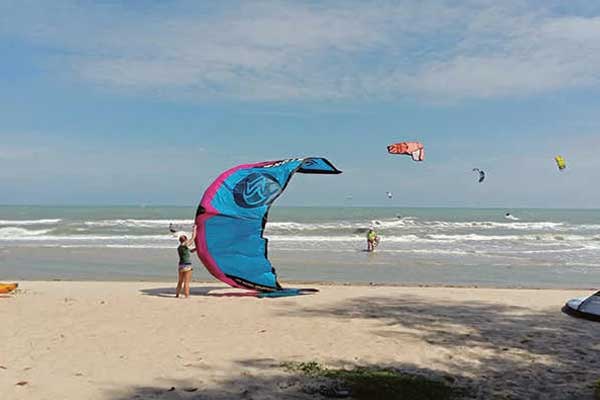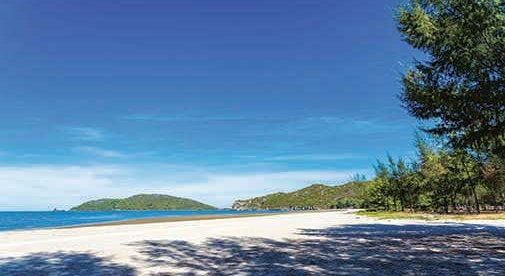Five years ago I took a three-day kiteboarding course in the little town of Pranburi, Thailand. It was three days well spent, but in the end I thought the sport wasn’t for me. Too much gear, too finicky, too much set up and break down, too complicated.
That course put me onto wakeboarding though, which I ended up doing several times a week behind boats and in cable parks. It’s great fun, but that element of freedom, of harvesting the wind to master the sea was missing. So in the year of COVID I returned to Pranburi, took another class, bought some gear and—as I secretly feared five years ago—went all-in.
I was going to have to move.
For 17 years I lived in Kanchanaburi, home of the world-famous River Kwai, and a nature lover’s paradise of mountains, rivers, and waterfalls. As one of the least populated provinces in Thailand, it also gives you plenty of space to breathe. For 14 of those years I lived in the same two-bedroom bungalow sitting on a quarter-acre garden (thanks to my landlord’s interest in horticulture). The rent was just over $100 a month including water and electricity. It’s no mystery why I stayed there so long.
Pranburi is a bit different—a lot more international. It’s close to Hua Hin, which is a major expat destination, and a weekend getaway for well-to-do Thais. Pranburi’s smaller, and ideal for those who want a beach town but not the development around it. That close proximity to Hua Hin, though, means that international shopping and dining opportunities are only 30 minutes away.
Making the move to Pranburi during the COVID shutdown made some sense beyond the need to kiteboard every day. I had been thinking about a move for a while and was even considering leaving Thailand, but that was ended by the international lockdown we all endured. What I found after spending my first month in Pranburi, living in a rented condo with a beach view and big pool for about $300 per month, was that all I needed was a change. It didn’t have to be an international change.
A rented condo with a beach view for $300 a month.
A new environment, a different cast of characters, and proximity to the sea did the trick. Pranburi’s location is excellent for kiteboarding in part because of the nearby mountains that make up Sam Roi Et National Park. The 300 peaks of the range direct the wind patterns, buffering the north wind during the cold season and sucking in the thermals in the hot season. These winds are then refined by Khao Kolack or skull mountain—an almost impossibly photogenic land mass that protrudes into the sea. Hiking trails reach its peak 300 feet above the sea, and also lead to a hidden beach at its tip.
Along the beach road of Pak Nam Pran—the seafront area of Pranburi— is a mix of boutique resorts, private homes, local seafood restaurants, and a few bistros run by expats. Among these is Tonto’s, a basic Thai restaurant with a million-dollar location right on the beach. It acts as the daytime gathering point for kiters from around the world. This group is overseen by local pro, Ae, who was my most recent instructor. Ae came from the impoverished northeast of Thailand looking for work. Over 13 years, he became one of the best kiters and teachers in the area.
Up the road from Tonto’s is the Beach House bar, run by English couple Karl and Michelle. The bar, which hosts special menu nights and DJ parties weekly is a hub for kiters young and old, international and local. Indistinguishable in their t-shirts and boardshorts, regardless of age or social status, they are bound together by the sport. Karl was the first foreign instructor in Pak Nam Pran, 14 years ago. “At the time, Hua Hin made more sense, business-wise, to set up a school and pub, but we knew that this place was special and was going to attract the right people,” Michelle says, when I ask how they ended up here.
Since then, Pak Nam Pran has grown to be the Venice beach of Thailand. Bangkok vacationers have found and fallen in love with the relaxed vibe and incredible sea views. Longboard surfers show up on Fridays in camper vans. Hipsters skateboard down the beach road, and local businesses are repositioning themselves to support this trend of Thais going California-style.
Pranburi isn’t only about kiteboarding. The local fishing culture is still alive and strong, since the expat community is relatively small compared to nearby Hua Hin. Just to the south of town is Sam Roi Et National Park, where a range of limestone peaks looms above a vast wetland, which attracts visitors for its lotus blooms as well as the domestic and migratory bird population. The serpentine roads that wind through the park, patrolled by troops of macaques, are a favorite run for motorcycles and cyclists alike.
Another natural spot in Pranburi is the mangrove preserve, open for both kayaking and stand-up paddle tours. Here, monitor lizards nearly the size of crocodiles can be seen lazing on the banks. The mangrove opens to the Pranburi river, where squidding boats are moored throughout the day. To the north of town, the pine woods of the Pranburi Forest Park sweep right to the sea, softening beaches and rock cliffs where day trippers and campers come to enjoy coastal Thailand in its natural state.
Kiteboarding is beautiful to watch. Brightly colored kites effortlessly tow their human masters, who skim across the water and then launch high in the air. Riders seem to float weightless, spinning and flipping in the air, before dropping back onto the water’s surface. Or… it should look like that. As a novice, it’s a complicated system of keeping the kite afloat and the board at the ready, then making them work in tandem. It often results in being dragged through the water until the out-of-control kite crashes.
In my experience, it’s been very difficult to learn. The kites generate tremendous power, which takes a skilled hand to control. People like sculptor Natanel Gluska, who came here only a few years ago but is at Tonto’s every day, make it all look simple and elegant. At 63, he’s lean and youthful, with a deep tan and shaved head. “This place is my paradise, sometimes I can’t believe my luck to be living here and have this place to ride every day,” he tells me. We’re on a break, enjoying a plate of dry-fried curry. It’s a speciality of the restaurant, served over white rice for about $1.20.
Sometimes I can’t believe my luck to be living here.
The group of kiters at Tonto’s have been a big help in encouraging me through the first week of disastrous kite crashes. They’ve commiserated with my long walks of shame back up the beach, carrying all my gear after a failed ride. They’ve also been a huge help in my getting settled here.
As with expats everywhere, food is a hot issue, and everyone has their own favorite local seafood place or international restaurant for a fancy dinner out. They also all have their own idea about the right place to live. Many live in the various gated communities here, some own condos, and a few live in simple, local-style ban nook houses out in the sticks, like I want to.
Coming here from the mainly rural province of Kanchanaburi, I knew Pranburi was going to be a bit more expensive to live in. It’s a beach town, and beach towns always cost a little more. I’ve found that normal Thai dishes cost as much as double near the beach, while many services like laundry and massage (in Thailand, massage is an everyday service) are about 20% more.

©John McMahon
Housing has proven to be a hard nut to crack. There is a tremendous amount of empty housing here, but most is rented to weekenders on platforms like Airbnb for rates that are far out of my budget range.
I knew I was never going to replicate my living situation from the last 14 years, but I’m dedicated to finding something I want: a small house with a garden and some privacy at a reasonable price. For now, I’m happy with the $300-a-month condo, where my furnished second-floor studio has beach views both front and rear.
I love the mountains, and if Pranburi weren’t so close to the same mountain range that ran through Kanchanaburi, it would have been a harder decision to settle down here. In fact, Thailand’s largest national park, Krang Krachen, is just over an hour away. There, all the endangered wildlife native to Thailand still exists. Some animals are almost impossible to sight, but it’s a lot easier to see monkeys, barking deer, and the occasional wild elephant. The area around the park is all wild and offers almost inexhaustible opportunities to rough it.
Back in Pranburi, on any given Tuesday night, the beach house is jammed with kiters for its Indian curry. Talk is about wind, kite sizes, and everything kite-related. It’s here that Edtha, an Australian in her 60s who lives full-time on Thailand’s other coast, tells me that if it were up to her she would stay in Pak Nam Pran year-round. At the moment, she keeps a small condo here for the kite season, “I love it here, I don’t mind it slow. I have friends here, I could just as easily give up the big house in Rayong but Charlie [her husband] won’t have it, he has to have the big towns.”
Each to their own. For me, though, Pak Nam Pran is a new home, a new experience, and, in a way, feels like a new Thailand. I don’t know if I will end up here for 17 years, like I did in Kanchanaburi, but as long as the wind keeps blowing and my legs will hold me up, I’m staying.
Related Articles
Find Your Dream Retirement in Thailand
Enjoy a Low Cost of Living in Thailand
Upcoming Conferences
The Only 2024 Fast Track Panama Conference
If your dream retirement involves stunning beaches… lush green mountains… a warm climate with no hurricanes… first-rate healthcare… incredible value for money (a couple can live well on $2,200 a month)… and the World’s #1 Retiree Discount Program…
Join our Panama experts and expats in February and discover why Panama could be your perfect paradise.
REGISTER NOW, SEATS LIMITED: EARLY BIRD DISCOUNT HERE


.png)